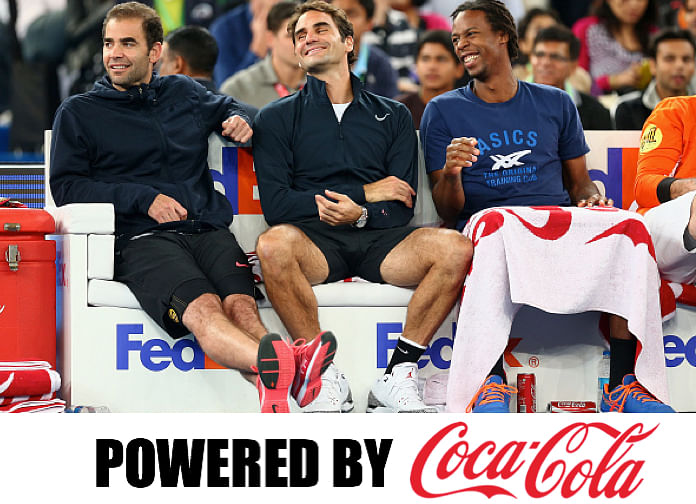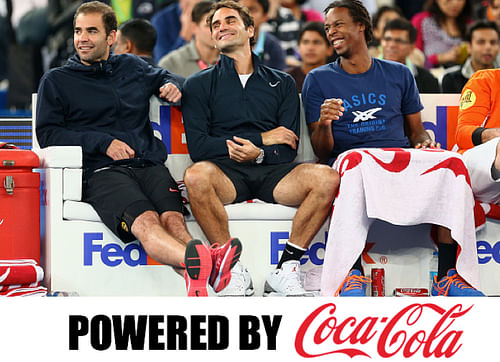
Coca-Cola IPTL: The legacy of legends a big draw for fans

The off-season this year is heralding a quiet revolution for tennis. The five-set feast is being lapped up eagerly by Asian fans who are hungry for excitement and the rare opportunity to see their favourite stars in action. The Coca-Cola IPTL is a medley of top class professionals, past and present, as they tour the continent with a product that is receiving plenty of positive feedback from spectators.
The Coca-Cola IPTL features the best players from past and current of tennis
It is the racy format that is inciting interest, just as much as the pedigree of the teams. While Roger Federer, Novak Djokovic and Andy Murray give the event an unprecedented gravity, legends of the sport such as Pete Sampras, Andre Agassi, Patrick Rafter, Carlos Moya and Lleyton Hewitt have added many layers of legacy to this fledgling league.
The weight of their contribution to the game and the undying love of their fans have meant that the legends of the game have been embraced warmly and celebrated fondly for the successes of their glorious past.
Of course, Coca-Cola has a rich history of associating with the legends of the sport. The one and only Arthur Ashe had been Coca-Cola’s brand ambassador for a long time, and the tie-up was groundbreaking for a lot of reasons.
But for now, as the IPTL travels across cities, the caravan is loaded with 28 Grand Slam titles and 213 ATP World Tour singles titles, besides four Davis Cups and an Olympic gold medal to boot. The teams consist of some marquee names, each legendary for their contribution to the history of this great sport.
Sampras and Agassi highlight the legends’ list
Sampras and Agassi need no introduction, irrespective of where they travel around the globe. The two men account for a staggering 22 Grand Slam titles and their fiesty rivalry consumed acres of published space during the past two decades.
Sampras ruled the tennis world with his powerful game and monk-like focus, reigning at the top for 286 weeks. That was a period during which the American collected an unprecedented 14 Grand Slam titles, including seven on the hallowed grass of Wimbledon.
Agassi’s was a two part act – in the first, he soared to the top with his flamboyant ways and a flowing game. His return of serve, considered among the best ever, meant that he was the biggest rival the world could offer Sampras.
Though he lost his way badly, Agassi resurrected himself with missionary zeal to return to the top after plumbing the depths of despair. The Agassi comeback story is a gripping tale of redemption that has captivated the senses of tennis fans across the world.
Magician Fabrice Santoro adds a French flair
Another legend Fabrice Santoro was called “the magician” by none other than Sampras. The Frenchman’s contribution to the sport can never be measured in numbers. Despite his diminutive frame, Santoro competed in an astounding 70 Grand Slam tournaments, playing some intricately nuanced tennis.
He made the most of his gifts, treating both opponents and fans to a very special experience amidst the growing dominance of power tennis. The genial Frenchman tasted Grand Slam success too, but both his titles came in doubles.
Australians stake their claim in the IPTL
The ability of Hewitt to scrap till his last ounce of energy has been extracted has defined the battle-worn Aussie. He continues to be an active player despite a spate of surgeries and a ravaged body, playing on instinct and an insatiable desire for a fight.
Patrick Rafter was as adept on the grass of Wimbledon, as he was on the hard courts of North America. The first man to accomplish the triple of Canada, Cincinnati and US Open, he was the bridge between the end of the Sampras era and the beginning of the Federer era. Both these Aussies – Hewitt and Rafter – have two Grand Slam titles each to their name.
The smaller countries have their legendary representatives too
Then there are the likes of Cedric Pioline, Mark Philippoussis and Carlos Moya, all of whom carved a special place for themselves in the annals of tennis history. Pioline was known for his all-court tennis style, Philippoussis was feared for his titanic serve, and Moya could rally with a consistency that bordered on the superhuman, as evidenced by his French Open victory in 1998.
The last word though should belong to Goran Ivanisevic. The Croat had a story of tragic heartbreak that lasted years before he could eventually court success at the All England club. After failing to take the final step previously, Ivanisevic finally won Wimbledon in fairytale manner as a wild card from out of the blue. That, and an emotional Davis Cup victory in 2005, defined one of the most alluring stories of modern tennis.
With so much legacy and so many stories on their wagon, the ‘Happiness Open’ is bound to enthrall fans with an unforgettable feast. Here’s a resounding ‘Cheers!’ to that.